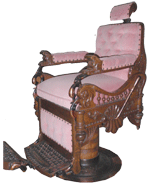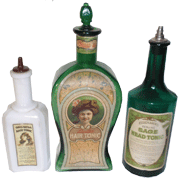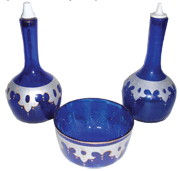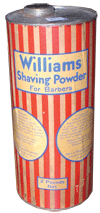|
Collectors Work Up A Lather For Barbershop Memorabilia
By Syl Turner
The barber industry has an interesting
history that can be traced back to the time
when barbers did more than just cut hair. In
earlier times, barbers performed surgery and
tooth extractions. In fact, the barber pole had
its origin with the practice of bloodletting.
There was a time, which extended into the
late 1800s, and in some rural parts of this
country into the early 20th century, when it
was believed that removing blood from an
ill person would rid them of the diseased
blood and affect a cure. The barber surgeon
would have the individual grasp a pole so
their veins would stand out. The blood was
collected in a basin, and linen cloths were
used to bandage the subject and for general
cleanup. The linens used for cleanup were
often reused and would be hung on the pole
and allowed to dry outside of the shop. The
wind sometimes twirled the red and white
bandages around the pole and this colored
swirl pattern was eventually adopted and
painted onto poles to identify the barber
shop.
These poles became permanent outdoor
advertising fixtures. In the United States, the
color blue was added to the pole as a patriotic
gesture. It was not until the early 20th century
that barber poles came to have the classic
rotating cylinder. In the early models, a
hand-wound clock-like mechanism turned
the striped cylinder. By the mid-1920s, most
barber poles had electric motors.
Antique barber poles can be found in a
variety of designs, shapes and sizes.
A 1930’s Koken barber shop wall-mount light pole
in good working condition will sell for up to $1,500,
but a fully-restored, porcelain enamel revolving
1920s lighted street pole will bring $6000 or more.
The barber pole is just one of a multitude of different barber
shop collectibles. Collectors are particularly drawn to what
might be called the “golden era” of the barbershop. The period
between 1880 and 1940 represents the “good old days” when
the barbershop was a bastion for males. It served as a meeting
place for men only, and while seated upon a “throne-like” chair,
they could for just a few coins get a haircut, a shave and catch
up on the latest town gossip.
The earliest chairs were made of wood and had four legs.
These wooden chairs often had elaborate carvings and were
upholstered with plush and fanciful fabrics. In 1874, Ernest
Koken of St. Louis started taking orders from local barbers
for custom-decorated shaving mugs, and the Koken Barber
Supply Co. was born. Soon after, Koken began selling chairs to barbers, and in 1881, the company patented the first Koken chair that reclined for shaving. A chair that revolved and reclined was
patented in 1885.
In 1892, Koken developed the first foot-pedal hydraulic
chair that later became the industry standard. At the turn of the
century, porcelain enameled cast-iron chairs came into vogue.
Today, Koken chairs are highly prized among barber chair
enthusiasts. An early cast iron chair in good working condition
can be found for under $500, while a completely reconditioned
chair could fetch $5,000 or more.
Barbershops during this period had elaborate back bars with
barber bottles containing hair tonic, hair oil, bay rum, witch
hazel, rosewater and in many shops, colorful bottles containing the barber’s unique concoction. Prior to the 1906 Pure Food and
Drug Act, bottles were not labeled but had distinctive colors so
the barber could identify the contents by the color of the bottle.
The contents of some bottles were specific to a special customer,
and the customer’s name was highlighted on the bottle.
Today, these bottles are prized by the barber bottle collector.
The personal identification of clientele was not limited
to bottles of hair tonic. Perhaps the most desirable of all
barbershop collectibles today is the occupational shaving mug.
Occupational mugs were not commonly
found in American barbershops until about
1880. These hard paste, white porcelain
mugs were originally from Staffordshire
England, France, and Germany but hand
decorated in this country. These were
personal mugs with an individual’s
name and a hand-painted image,
representing the patron’s occupation.
Patrons thought it was more hygienic
to have their own personal shaving mug
and in so doing, thought they would
eliminate a shaving rash. Any rash the
customer experienced, however, came not
from the mug that was used, but from the
unsanitary razor used by the barber.
Nevertheless, such mugs served as a
status symbol; not only for the customer,
but the amount of mugs the barber had
on display in his mug rack was a visual
representation of the size of his customer
base.
Common household mugs sell for
as little as $10-$30, but occupational
mugs can range from $400 to as much
as $5,000, depending upon condition
and the rarity of the occupation.
Of course, we can’t talk about shaving
without mentioning the straight razor
and the strop used for honing the blade.
Straight razors required considerable
skill to hone and strop and even more
skill and care during the actual shave.
This was a major part of the curriculum
of early barber colleges. Straight
razors remained the barbers’ razor of
choice, even after the introduction of Gillette’s Safety Razor in 1904.
Prices for antique straight razors
depend upon the material from which
the handle is made, such as bakelite,
bone, mother of pearl, tortoise shell,
etc. A decoration on the blade is another
factor in valuing an antique straight
razor. The blade could be decorated by
engraving and/or gold leafing or on less
expensive models, by acid engraving.
The maker is another factor with the
German manufactures being the most
desirable. Prices for antique straight
razors range from $10 to $100 or more.
Other barbershop collectibles
include sterilizers, disinfectant jars,
shaving brushes, shaving soaps, waste
jars, barber signs, clothes brushes, and
just about anything related to barbering
that has disappeared, having been
replaced by modern unisex salons.
Syl Turner is the owner and
operator of the Broad Street Antique
Mall in Chamblee, Ga. Many of the
photographed items in this article, along
with hundreds of additional barbershop collectibles, can be
found in the Broad Street Antique Mall, or accessed from the
web site: BroadStreetAntiqueMall.com
|

Ca. 1927 Emil
J. Paidar
fully restored
porcelain street
barber pole,
$6,000.

Berninghaus “Hercules” Barber Chair, 1901, used in
the movie, The Time Machine; $15,000-$20,000. (Photo
courtesy, the J. Kimble Collection.)

Ca.1900 hair tonic
bottles,
$75-$100 each.

Two Blue Persian design
barber bottles with
manicure bowl, ca.
1900, $650.

Williams
Shaving
Powder,
ca.
1930, $50.
|